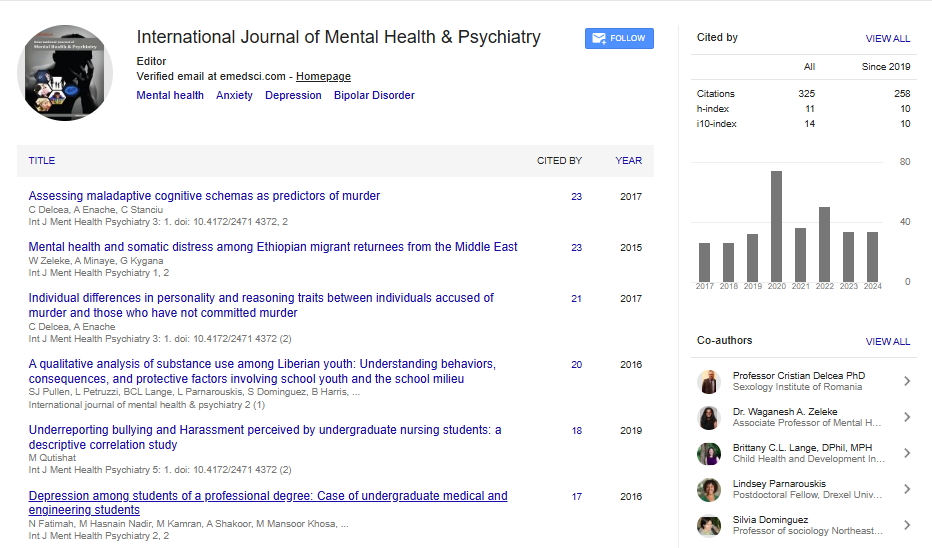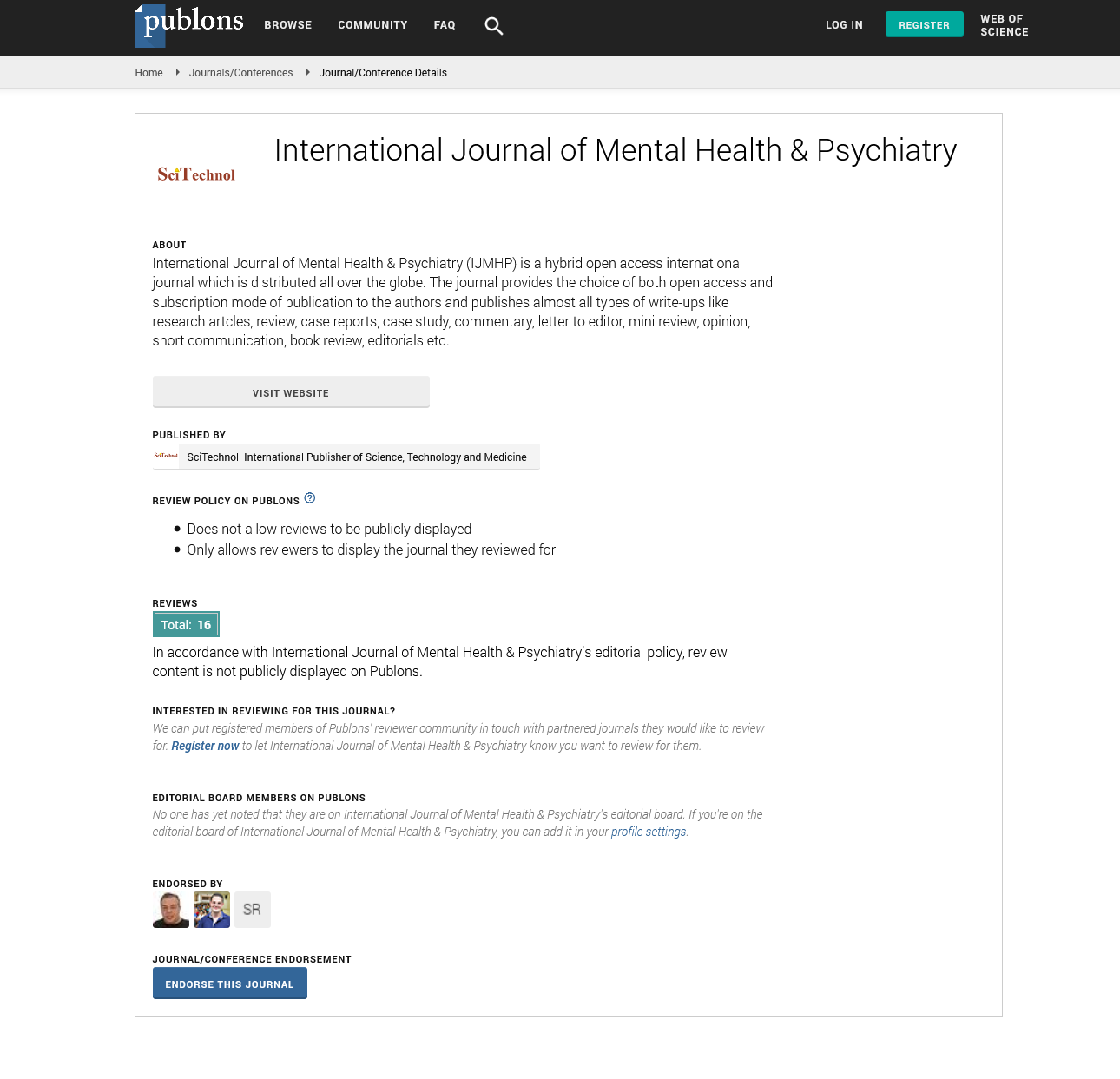Commentary, Int J Ment Health Psychiatry Vol: 10 Issue: 4
The Dimensions of Suicidology: Causes, Prevention and Intervention Strategies
Laura Martinez*
1Department of Psychiatry, Cairo University, Cairo, Egypt
*Corresponding Author: Laura Martinez,
Department of Psychiatry, Cairo University,
Cairo, Egypt
E-mail: martinezl287@gmail.com
Received date: 26 November, 2024, Manuscript No. IJMHP-24-154318;
Editor assigned date: 28 November, 2024, PreQC No. IJMHP-24-154318 (PQ);
Reviewed date: 12 December, 2024, QC No. IJMHP-24-154318;
Revised date: 20 December, 2024, Manuscript No. IJMHP-24-154318 (R);
Published date: 27 December, 2024, DOI: 10.4172/2471-4372.1000277
Citation: Martinez L (2024) The Dimensions of Suicidology: Causes, Prevention and Intervention Strategies. Int J Ment Health Psychiatry 10:4.
Description
Suicidology, the scientific study of suicidal behavior, its causes and prevention, is an essential yet complex field in mental health research. The alarming global statistics surrounding suicide highlight the urgent need for a deeper exploration of its complexities to develop effective intervention strategies. This article enquires into the multifaceted aspects of suicidology, including risk factors, protective measures and approaches to reducing its prevalence. Suicidology encompasses a broad spectrum of studies focusing on psychological, biological, social and cultural factors influencing suicidal behavior. This field investigates the motivations behind self-harm, the demographic patterns of affected populations and the efficacy of intervention techniques. The ultimate goal is to reduce suicide rates through improved understanding and proactive measures.
Factors contributing to suicide
Multiple factors contribute to suicidal tendencies, often forming a complex connection between personal, societal and biological elements.
It is essential to note that no single factor predicts suicide; instead, it is usually the culmination of multiple stressors and personal crises. These include:
Mental health disorders: Depression, anxiety, bipolar disorder and schizophrenia are leading contributors.
Trauma and abuse: Experiences such as childhood abuse, sexual violence, or neglect often lead to emotional scars that increase vulnerability.
Social isolation: Loneliness and a lack of support systems can amplify feelings of hopelessness.
Substance abuse: Drugs and alcohol impair judgment, exacerbating mental health struggles.
Chronic illnesses: Physical pain or terminal diseases often cause despair.
The role of protective factors
While risk factors heighten the likelihood of suicidal behavior, protective factors can mitigate these risks. Strengthening these factors is central to suicide prevention initiatives globally. Key protective measures include:
Support networks: Strong family and community connections can provide emotional grounding.
Access to mental health care: Timely therapy or counseling significantly reduces risks.
Life skills training: Coping strategies for managing stress and conflict are vital in building flexibility.
Education and awareness: Programs that demystify mental health struggles encourage individuals to seek help without stigma.
Prevention strategies
Addressing suicide requires a multidimensional approach:
Public awareness campaigns: Societal stigma surrounding mental health often discourages individuals from seeking help. Awareness campaigns foster open conversations and challenge misconceptions.
Training for gatekeepers: Teachers, doctors and community leaders are often the first to notice warning signs. Equipping them with the skills to intervene is essential.
Crisis helplines: Easily accessible hotlines staffed with trained counselors provide immediate support to those in distress.
Policy interventions: Governments play a precarious role in creating frameworks for better access to mental health care and restricting access to means of suicide, such as firearms and hazardous chemicals.
Intervention approaches
For individuals at immediate risk, timely intervention is vital. Mental health professionals employ techniques such as Cognitive Behavioral Therapy (CBT) and Dialectical Behavior Therapy (DBT) to address suicidal ideation. Family-based interventions and peer support programs also create a safety net for vulnerable individuals. Continued research in suicidology is essential for developing innovative solutions. Studies examining genetic predispositions, neurobiological pathways and cultural influences provide new insights. Meanwhile, advances in technology, such as AI-driven mental health monitoring and virtual therapy platforms, are expanding the field's potential. Suicide is a global concern, affecting individuals of all ages, genders and socioeconomic backgrounds. However, disparities exist in prevalence and prevention efforts across regions.
Collaborative efforts between governments, healthcare providers and communities are vital to ensure equitable access to resources and culturally sensitive interventions. As the field of suicidology evolves, the focus should remain on development hope and flexibility. By addressing systemic gaps in mental health care and promoting supportive environments, society can collectively work towards reducing the burden of suicide. The challenge is significant, but with a united effort, meaningful progress is achievable. Suicidology not only seeks to understand the phenomenon of suicide but also aims to instill hope for a future where every life is valued and safeguarded. By investing in prevention and intervention, the world takes a step closer to achieving this vision.
 Spanish
Spanish  Chinese
Chinese  Russian
Russian  German
German  French
French  Japanese
Japanese  Portuguese
Portuguese  Hindi
Hindi 
